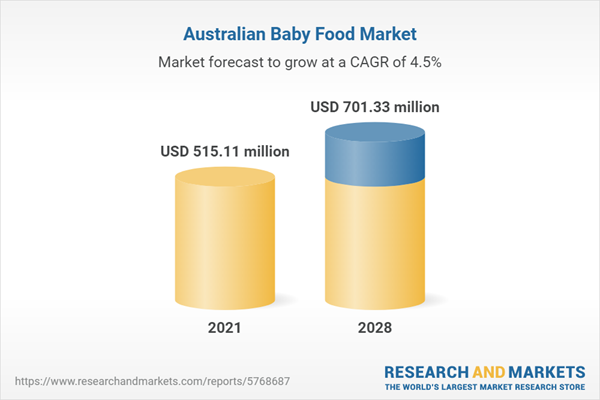The Australian baby food market is expected to grow at a compound annual growth rate of 4.51% over the forecast period to reach a market size of US$701.332 million in 2028, from US$515.112 million in 2021.
Baby food is regarded to be an ideal substitute for breast milk owing to the presence of essential and necessary nutrients that are efficient in aiding in the growth of infants. These baby foods consist of fruits, cereals, and even vegetables that are carefully crafted and then prepared for children aged four months to two years.The surge in women professionals and improved awareness of adequate nutrition.
There has been an increase in working women professionals in Australia. According to the Australian Bureau of Statistics, over the period of 50 years, women’s participation in paid work has subsequently increased significantly and recently till 2020, women in Australia made up almost half of the paid workforce. With such an increase in the participation of women professionals, working mothers are stuck in their fast-paced and hectic lifestyles, resulting them in having less time to prepare healthy nutritious meals for their children or even breastfeed their babies. This certain factor acts as a growth driver resulting in the adoption of prepared baby food among working professionals. In this regard, it also results in an improved awareness of the adequate amounts of nutrition that a child is supposed to have. In order to shape the baby’s health, dietary practices are adopted by mothers which are regarded to be a key factor. Moreover, Australia has accounted for a rise in the literacy rate of females, which is further driving the Australian baby food market toward growth owing to the nutritious content present in baby food.Furthermore, rising disposable income is expected to drive sales further. Organic baby food products are usually considered to be costlier than non-organic ones due to the extra effort that goes into their processing. However, with the rise in purchasing power coupled with the growing health awareness among parents, the organic baby food segment is expected to experience decent growth. According to the Australian Bureau of Statistics, the gross disposable income per household saw an annual increase of 3.7% from the 2020-21 period to the 2021-22 period.
Key developments.
In 2021, Max Biocare which is an Australian pharma and nutraceutical company is moving forward with the expansion of its baby food brand Little Etoile in Australia which will be efficient in providing a new infant and toddler formula range. Moreover, in 2019, Buds Australia partnered with Fonterra for the specific launch of their new grass-fed infant formula which will be available in pharmacies throughout Australia.Based on product type, the Australian baby food market is segmented into organic baby food and non-organic baby food. The organic baby food segment is expected to grow in the region due to the rising consciousness among parents regarding the nutrition and health of their infant children. The strong presence of market players in this segment like Bellamy’s Organic and Bubs Organic, among others are expected to drive growth in the market. Adding to that, the growing amount of novel product launches in the country along with increasing disposable income are further projected to drive growth in the market.
Based on the food category, the baby food market in Australia has been segmented into dried baby food, milk formula, prepared baby food, and others. The increased stress of childcare on working women in Australia is expected to drive the purchasing habit of women to buy convenient baby food like milk formula in the forecast period, thereby increasing the overall share of milk formula in the Australian market.
Market Segmentation:
By Product Type
- Organic Baby Food
- Non-Organic Baby Food
By Distribution Channel
- Online
- Offline
By Food Category
- Dried Baby Food
- Milk Formula
- Prepared Baby Food
- Others
Table of Contents
1. INTRODUCTION1.1. Market Overview
1.2. Market Definition
1.3. Scope of the Study
1.4. Market Segmentation
1.5. Currency
1.6. Assumptions
1.7. Base, and Forecast Years Timeline
2. RESEARCH METHODOLOGY
2.1. Research Data
2.2. Research Design
3. EXECUTIVE SUMMARY
3.1. Research Highlights
4. MARKET DYNAMICS
4.1. Market Drivers
4.2. Market Restraints
4.3. Porter's Five Forces Analysis
4.3.1. Bargaining Power of Suppliers
4.3.2. Bargaining Power of Buyers
4.3.3. Threat of New Entrants
4.3.4. Threat of Substitutes
4.3.5. Competitive Rivalry in the Industry
4.4. Industry Value Chain Analysis
5. AUSTRALIA BABY FOOD MARKET ANALYSIS, BY PRODUCT TYPE
5.1. Introduction
5.2. Organic Baby Food
5.3. Non-Organic Baby Food
6. AUSTRALIA BABY FOOD MARKET ANALYSIS, BY DISTRIBUTION CHANNEL
6.1. Introduction
6.2. Online
6.3. Offline
7. AUSTRALIA BABY FOOD MARKET ANALYSIS, BY FOOD CATEGORY
7.1. Introduction
7.2. Dried Baby Food
7.3. Milk Formula
7.4. Prepared Baby Food
7.5. Others
8. COMPETITIVE ENVIRONMENT AND ANALYSIS
8.1. Major Players and Strategy Analysis
8.2. Emerging Players and Market Lucrativeness
8.3. Mergers, Acquisitions, Agreements, and Collaborations
8.4. Vendor Competitiveness Matrix
8.5. Market Share Analysis (Infant/Milk Formula)
9. COMPANY PROFILES
9.1. Nestle Australia
9.2. Bellamy’s Organic
9.3. PZ Cussons plc
9.4. Bubs Australia Limited
9.5. Abbott Australasia Pty. Ltd.
9.6. Danone S.A
9.7. Kraft Heinz Company
9.8. The A2 Milk Company
9.9. Wellnex Life Limited
9.10. Blackmores Limited
Companies Mentioned
- Nestle Australia
- Bellamy’s Organic
- PZ Cussons plc
- Bubs Australia Limited
- Abbott Australasia Pty. Ltd.
- Danone S.A
- Kraft Heinz Company
- The A2 Milk Company
- Wellnex Life Limited
- Blackmores Limited
Methodology

LOADING...
Table Information
| Report Attribute | Details |
|---|---|
| No. of Pages | 104 |
| Published | February 2023 |
| Forecast Period | 2021 - 2028 |
| Estimated Market Value ( USD | $ 515.11 million |
| Forecasted Market Value ( USD | $ 701.33 million |
| Compound Annual Growth Rate | 4.5% |
| Regions Covered | Australia |
| No. of Companies Mentioned | 10 |









